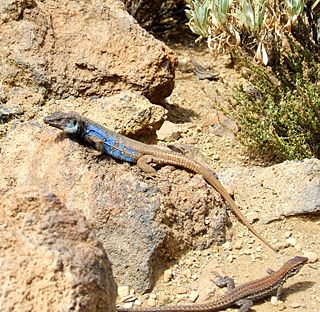
The genus Gallotia are the lacertids of the Canary Islands. This genus consists of a group that has been evolving there ever since the first islands emerged from the sea over 20 million years ago. The endemic species and subspecies of this group have a number of characteristics that make them quite special within their family (Lacertidae); their only close relatives are the sandrunner lizards (Psammodromus) of the western Mediterranean region. Gallotia are characteristic for eating significant quantities of plants, and several lineages are often presented as classic examples for insular gigantism. However, a find of an even larger Gallotia species from the early Miocene of mainland Europe casts doubt on this assumption. Instead the ancestor of all modern Gallotia species of the Canary islands was probably already very large but carnivorous.

The La Gomera giant lizard is a lacertid species that can be found on the island of La Gomera, one of the Canary Islands.

The El Hierro giant lizard is the only extant, critically endangered subspecies of Simony's giant lizard. It is endemic to El Hierro, the westernmost of the Canary Islands, where it is an official symbol.

Island gigantism, or insular gigantism, is a biological phenomenon in which the size of an animal species isolated on an island increases dramatically in comparison to its mainland relatives. Island gigantism is one aspect of the more general "island effect" or "Foster's rule", which posits that when mainland animals colonize islands, small species tend to evolve larger bodies, and large species tend to evolve smaller bodies. This is itself one aspect of the more general phenomenon of island syndrome which describes the differences in morphology, ecology, physiology and behaviour of insular species compared to their continental counterparts. Following the arrival of humans and associated introduced predators, many giant as well as other island endemics have become extinct. A similar size increase, as well as increased woodiness, has been observed in some insular plants such as the Mapou tree in Mauritius which is also known as the "Mauritian baobab" although it is member of the grape family (Vitaceae).
The La Palma giant lizard is a large wall lizard endemic to the island of La Palma in the Canary Islands, currently extinct or critically endangered.

Simony's giant lizard is a large species of wall lizard endemic to the island of El Hierro and nearby islet Roque Chico de Salmor in the Canary Islands.

The Roque Chico de Salmor giant lizard is the extinct nominate subspecies of Simony's giant lizard, which was endemic to the small islet Roque Chico de Salmor northwest of El Hierro, the westernmost of the Canary Islands.

Boettger's lizard is a species of wall lizard in the family Lacertidae. The species is endemic to the Canary Islands. There are two recognized subspecies.

Gallotia galloti, also known commonly as Gallot's lizard, the Tenerife lizard, and the Western Canaries lizard, is a species of wall lizard in the genus Gallotia. The species is native to the Canary Islands of Tenerife and La Palma. Unlike most larger species of its genus, G. galloti is a commonly found animal. There are four recognized subspecies.
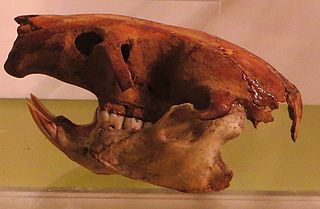
The Tenerife giant rat is an extinct species of rodent endemic to the island of Tenerife, the largest of the Canary Islands, Spain. Many remains have been found during archeological digs. Most remains are from the Pleistocene. Radiocarbon dating has placed some of the finds in the late Pleistocene.

The West Canary skink, also known commonly as the Canaryan cylindrical skink, East Canary Islands skink, the Tenerife skink, is a species of lizard in the family Scincidae. The species is endemic to the Canary Islands.

The Gomero wall gecko or La Gomera gecko, also known as perenquén in the Canary Islands, is a species of lizard in the family Phyllodactylidae. It is endemic to La Gomera.
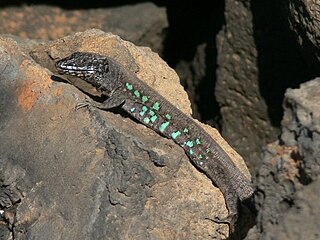
The Atlantic lizard is a species of lizards in the family Lacertidae. It is endemic to the eastern Canary Islands Lanzarote and Fuerteventura and the smaller islands surrounding them.

The Gran Canaria giant lizard is a species of lizard in the family Lacertidae. The species is found in the Canary Islands.

The Aran rock lizard is a species of lizard in the family Lacertidae.
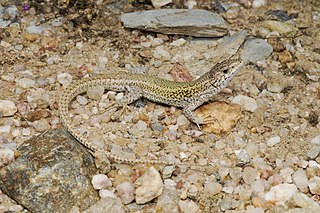
Podarcis carbonelli, commonly known as Carbonell's wall lizard, is a species of lizard in the family Lacertidae. The species is native to Portugal and Spain.

Lilford's wall lizard is a species of lizard in the family Lacertidae. The species is endemic to the Balearic Islands, Spain.
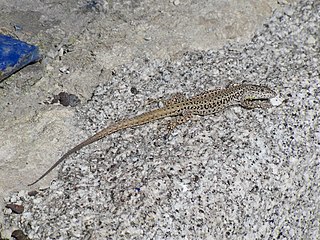
Podarcis vaucheri, the Andalusian wall lizard, is a species of lizard in the family Lacertidae. The species is native to northern Africa and southern Spain.
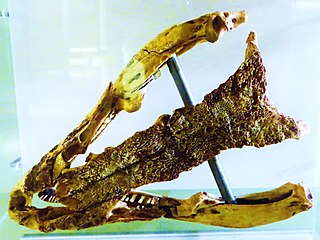
Gallotia goliath is an extinct giant lizard species from the island of Tenerife of the Canary Islands, Spain. This reptile lived before the arrival of humans and is believed to have grown to at least 0.9 metres (3.0 ft) long. It was described by the German herpetologist Robert Mertens. Fossils of this lizard have been found in volcanic caves, where they often appear with those of other animals, like the Tenerife giant rat.

















